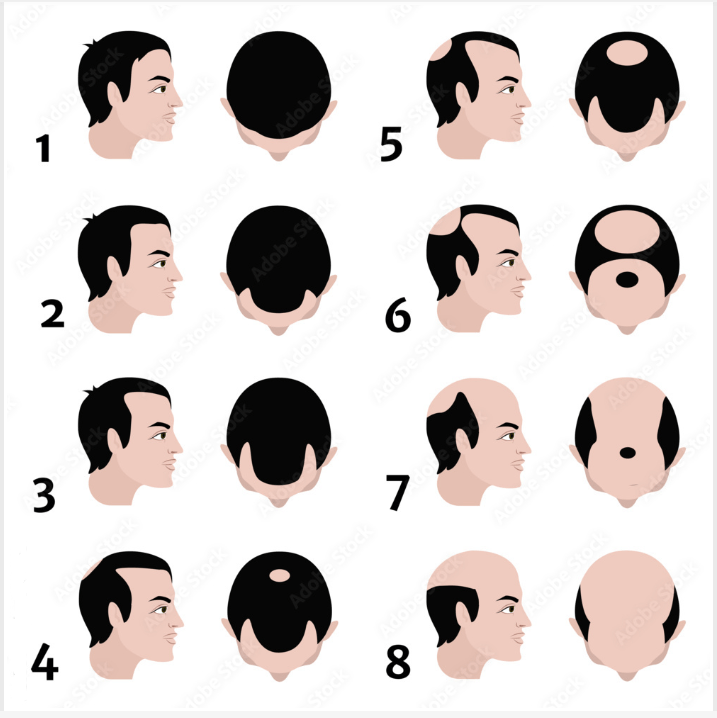FREE SHIPPING OVER $50
Understanding the Norwood Scale from Stages 1-7
The Norwood Scale, also known as the Norwood Balding Scale or Hamilton-Norwood Scale, is a classification system used to measure the extent of male pattern baldness. It provides easy-to-reference images that indicate different stages of balding. The scale has seven stages, each measuring the severity and pattern of hair loss.
The Stages of the Norwood Scale

Norwood Scale 1
Stage 1 on the Norwood Scale represents no significant hair loss or receding hairline. The hairline is full, and there are no signs of thinning or baldness. This is the stage where most young men would find themselves.
Norwood Scale 2
Stage 2 is characterized by a slight recession in the hairline. This is often referred to as an adult or mature hairline. It’s not necessarily a sign of impending baldness, but it may be the first indication that the hairline is moving.
Norwood Scale 3
Stage 3 is where clinically significant hair loss occurs. At this stage, most men show a deep symmetrical recession at the temples that are bare or sparsely covered by hair. This is often where the first signs of baldness appear.
Norwood Scale 4
In Stage 4, there is further frontal hair loss and enlargement of vertex, but there is still a solid band of hair across top separating front and vertex. This stage represents a more significant progression towards baldness.
Norwood Scale 5
Stage 5 shows still more severe decline, but there is still some hair remaining mid-scalp. The areas of hair loss are larger than in stage 4, and a thin division of hair may remain between the two areas of hair loss.
Norwood Scale 6
In Stage 6, the bridge of hair that once crossed the crown is gone with only sparse hair remaining. The bald areas in the front and back of the head are still separate. This stage represents extensive hair loss.
Norwood Scale 7
Stage 7 is the most severe stage of male pattern baldness. There is only a wreath of hair remaining in the back and sides of the scalp. At this stage, the hair loss is severe and concentrated in the front, top, and crown of the head.
Diagnosing Baldness
Diagnosing baldness typically involves a combination of a physical examination, review of family and medical history, and sometimes specific tests.
Physical Examination
A physical examination is usually the first step in diagnosing hair loss. The doctor will examine your scalp to see the pattern of hair loss.
Review of Family and Medical History
Your doctor will ask about your family and medical history. This can provide clues about the cause of your hair loss. For example, if you have a family history of baldness, you’re more likely to experience hair loss.
Specific Tests
There are several tests that can help diagnose the cause of hair loss:
- Complete Blood Count (CBC): This test checks for hemoglobin levels and other markers to help identify medical conditions associated with hair loss.
- Thyroid Function Tests (TFTs): These tests check for hormone levels.
- Pluck Test: Hair is pulled from the root for examining the phase of growth to detect a defect.
- Pull Test: Pulling several hairs from a particular area to see how many come out.
- Trichoscopy: This is done using a dermatoscope which consists of a light source and a lamp to examine the scalp/skin.
- Scalp Biopsy: Scraping samples from the skin for further examination to detect infection.
Causes of Male Pattern Baldness
Male pattern baldness, also known as androgenetic alopecia, is a common condition that causes hair loss in men. It can also affect women, although it is less common. The exact cause of male pattern baldness is not fully understood, but it is thought to be due to a combination of genetic and hormonal factors.
- Genetics: One cause of male pattern baldness is genetics, or having a family history of baldness. Research has found that male pattern baldness is associated with male sex hormones called androgens. If your mother’s father (maternal grandfather) has male pattern baldness, there’s a good chance that you’ll have male pattern baldness as well. However, there may be a link between male pattern baldness and your father. If your father is bald, you’re twice as likely to have male pattern baldness.
- Hormonal Factors: The androgens have many functions, including regulating hair growth. Each hair on your head has a growth cycle. With male pattern baldness, this growth cycle begins to weaken and the hair follicle shrinks, producing shorter and finer strands of hair. Eventually, the growth cycle for each hair ends and no new hair grows in its place.
- Age: The chances of developing male pattern baldness increase with age. About 25% of people assigned male at birth see the first signs of hair loss before age 21. By age 50, half experience hair loss, and about 70% will lose hair as they get older.
Treatment of Hair Loss
Hair loss can be a distressing condition, but several treatments can help manage the condition and, in some cases, promote hair regrowth.
- Medications: There are several medications available that can help treat hair loss. These include Minoxidil, an over-the-counter topical treatment that can help slow hair loss and promote hair regrowth in some people. Another medication is Finasteride, a prescription pill that can help slow hair loss and even lead to new hair growth.
- Hair Transplant Surgery: For some people, hair transplant surgery may be a good option. This involves moving small plugs of skin, each containing a few hairs, from parts of your scalp where hair is still growing to the bald or thinning areas.
- Lifestyle Changes: Certain lifestyle changes can also help manage hair loss. This includes eating a healthy diet rich in protein, iron, and other key nutrients that support hair health. Avoiding tight hairstyles and harsh treatments can also help prevent hair loss.
Preventing Hair Loss
While it’s not always possible to prevent hair loss, especially if you have a genetic predisposition to it, some strategies may help.
- Healthy Diet: Eating a balanced diet can help keep your hair healthy. Include plenty of lean proteins, fruits, vegetables, and whole grains in your diet. Avoid crash diets, as rapid weight loss can cause hair loss. Ensure you take the essential vitamins that support hair growth.
- Avoid Damaging Hairstyles: Tight hairstyles, such as ponytails, braids, or buns, can pull on the hair and cause tension, which can lead to hair loss. Try to wear your hair down as much as possible.
- Limit Heat and Chemicals: Frequent use of heat-styling tools, like flat irons and curling irons, can damage hair and cause it to break off. Similarly, chemical treatments, like perms and color treatments, can weaken hair and lead to loss.
- Protect Your Hair from Sunlight: Just like your skin, your hair can be damaged by the sun. Wear a hat or use a hair sunscreen to protect your hair from sun damage.
Diffuse Thinning and the Norwood Scale
While the Norwood Scale is useful, it doesn’t cover all types of hair loss. For instance, some men experience diffuse thinning, a type of hair loss where hair falls out from all areas of the scalp. This is different from the typical pattern of male pattern baldness, which usually starts with a receding hairline or bald spot at the crown.
Conclusion
Understanding the Norwood Scale can help you identify the stage of your hair loss and guide potential treatment strategies. However, it’s always best to consult a healthcare provider or a dermatologist for an accurate diagnosis and treatment options.
Related Articles
- What is Diffuse Thinning and How to Stop It
- Amika’s Perk Up Dry Shampoo Review
- Vitamin Deficiency and Hair Loss: What You Need to Know
- Why Nutrafol? Discover the Key Benefits for Hair Restoration
- Microneedling: Benefits, Side Effects, Cost, and More
- Managing Seborrheic Dermatitis Symptoms: Home Remedies for Relief



